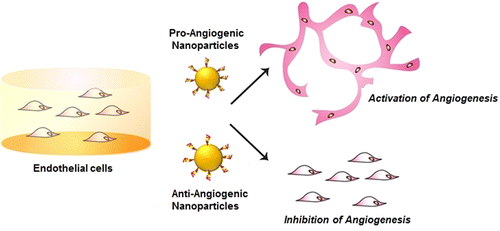(Phys.org) —Researchers at the University of Southampton in the U.K. have devised a means for using nanoparticles to cause angiogenesis (the growth of new blood vessels) to speed up or slow down. In their paper published in ACS Nano, the researchers describe how they coated gold nanoparticles with peptides to allow for altering the speed at which new blood vessels develop in specific locations in the body.
The development of new blood vessels is critical while wounds are healing. It's also important in helping people recover from accidents or who have tissue damaged by disease. Speeding up angiogenesis can help to speed up recovery times. Sometimes however, angiogenesis can progress incorrectly resulting in the growth of tumors. In these instances, doctors would like to slow or stop the angiogenesis process. In this new effort, the research team has found a new way to accomplish both goals with one new treatment option.
The new technique revolves around the use of nanoparticles—very small objects generally not found in nature. In this case, the particles created were made of gold. Because nanoparticles can so easily move around inside the body, the thinking was that nanoparticles could be used to deliver drugs to specific areas of the body where they are needed. In this case, the drugs were peptides that have been shown to speed up angiogenesis when appropriate and to slow the process when tumors have developed. The ability to deliver the drug only to areas where they are needed reduces side-effects.
In order for angiogenesis to occur, endothelial cells must be activated by the presence of certain molecules engaging with receptor cells. Over time, researchers have developed various drugs to either stimulate or repress angiogenesis by activating the receptor cells or block them. Such drugs have only been useful for a short duration, however, and most often come with unwanted side effects. In this new effort, the team used nanoparticles to carry and deliver such drugs only to the parts of the body that needed them. They found they could target specific receptor cells that allow for focusing on different diseases. Specifically, they developed three types of peptides for delivery via nanoparticles: those that bind and promote cascade growth of blood vessels, those that block receptors cells from receiving signals, and those that serve as a control and do nothing. They report that they were successful in delivering all three types to target areas and that doing so caused the expected changes in angiogenesis rates.
More information: Manipulation of in Vitro Angiogenesis Using Peptide-Coated Gold Nanoparticles, Dorota Bartczak, Otto L. Muskens, Tilman Sanchez-Elsner, Antonios G. Kanaras, and Timothy M. Millar, ACS Nano Article ASAP. pubs.acs.org/doi/abs/10.1021/nn402111z
Abstract
We demonstrate the deliberate activation or inhibition of invitro angiogenesis using functional peptide coated gold nanoparticles. The peptides, anchored to oligo-ethylene glycol capped gold nanospheres, were designed to selectively interact with cell receptors responsible for activation or inhibition of angiogenesis. The functional particles are shown to influence significantly the extent and morphology of vascular structures, without causing toxicity. Mechanistic studies show that the nanoparticles have the ability to alter the balance between naturally secreted pro- and anti-angiogenic factors, under various biological conditions. Nanoparticle-induced control over angiogenesis opens up new directions in targeted drug delivery and therapy.
via Nanotechweb
Journal information: ACS Nano
© 2013 Phys.org





















